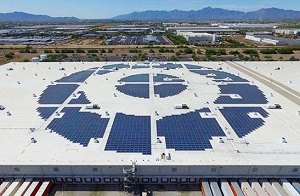WASHINGTON, July 26, 2017 - Target has set chain-wide corporate social responsibility (CSR) goals designed to increase the company’s energy efficiency. Board Chairman and CEO Brian Cornell said the company is using the United Nations’ 2015 Sustainable Development Goals as a guide.
“We are determined to find the best ways to support the UN Sustainable Development Goals of ending poverty, fighting inequality and protecting our planet,” Cornell said. “We are thinking boldly about how we can leverage our size and scope to address global problems, from reducing our environmental footprint to improving livelihoods at all points in our supply chain.”
The company is already well on its way to completing sustainability plans well ahead of their 2020 due date. Jennifer Silberman, VP for corporate responsibility, said one of the retailer’s objectives is to protect and use natural resources wisely.
“To work toward this, we doubled down on solar installations and made our first partnership in wind power,” said Silberman. “We were also named as Energy Star Partner of the Year for the second year in a row,” she said, referring to the federal government energy-saving program.
In 2016, the retailer restarted its Energy Star certification process, with a goal of having 80 percent of stores Energy Star-certified by 2020. Last year, 76 percent of Target’s buildings had achieved certification.
“Target Corporation leads the retail sector with more than 1,400 Energy Star certified buildings across the nation,” said EPA’s Jean Lupinacci, who runs the Energy Star Commercial and Industrial Branch. “From innovative programs that leverage building automation and energy systems to their dedication to portfolio-wide energy efficiency improvements, Target is leading the way toward creating a cleaner, healthier environment for us all.”
 One of 13 solar installations at Arizona Target stores.
One of 13 solar installations at Arizona Target stores.
In 2016, the retailer added rooftop solar panels to 157 new sites, ending the year with 350 total, for a capacity of 166.3 megawatts. In the next three years, Target plans to have solar panels at 500 stores. On average, a Target store with onsite solar uses 30 percent less energy from the local electric grid than those without. In some cases, Target may generate the solar energy in support of utility and state clean energy programs and policies.
Last year, Target launched its first wind-power partnership by buying a portion of the energy produced by Starwood Energy Group’s 211-megawatt Stephens Ranch Wind Project near Lubbock, Texas. The partnership offsets 100 percent of the energy used at 60 stores throughout Texas. Target hopes to sign similar agreements with more renewable energy producers.
The company also plans to reduce the energy intensity per square foot by 10 percent. Target is pursuing efficiency projects in HVAC, lighting and refrigeration. In 2016, it reduced energy intensity by 2.32 percent from the 2010 baseline. In 2017, the store will continue to make significant investments in LED lighting conversions in pursuit of its 2020 goal. No plans have been made to improve efficiency in company automobiles.
#30


